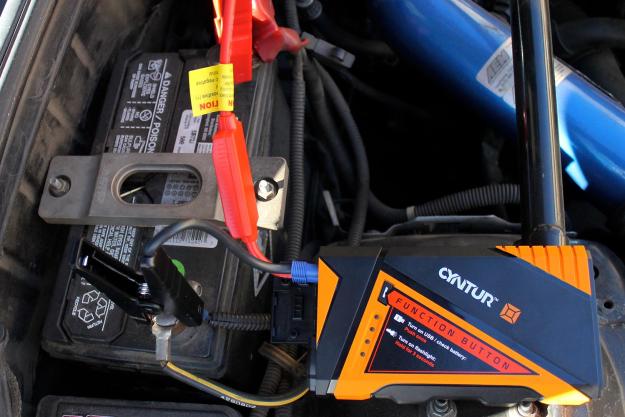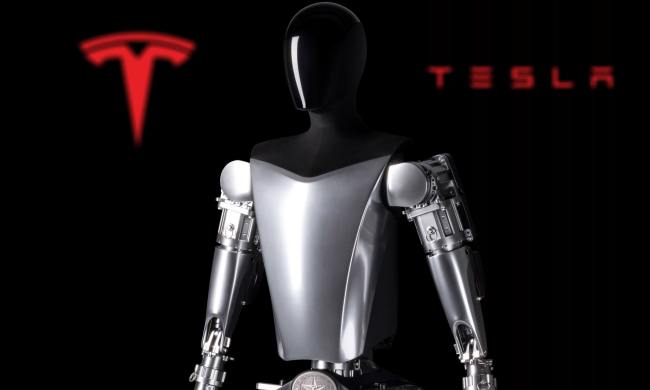
“As portable as it is functional, Cyntur’s JumperPack mini boasts all the features of full-size jump boxes … and then some.”
- Great price
- Has the juice to jump 4, 6, and 8-cylinder engines
- USB port can charge mobile devices
- Rugged construction
- 200-lumen LED light can be used as an emergency strobe
- No car charger included
- Some charging claims may be a tad optimistic
You could have the coolest, fastest, and most stylish ride in the world, but if it doesn’t start, it might as well be expensive lawn décor.
We’ve all been there: leaving the dome light on, the door cracked, or maybe you just had an old battery. You knew you should’ve sprung for a new one instead of that fancy subwoofer. Nevertheless, you have places to go and an unresponsive hunk of junk.
In the good ol’ days, jumping your car meant hauling a cumbersome, oft-wheeled unit out from the garage, or perhaps recruiting a friend to push you for a bump-start. With portable jump boxes like the Cyntur JumperPack mini, those days are over.
The great revival
Let’s start with the basics; this is a jump-starter after all. The $99.99 Cyntur JumperPack mini is small, sturdily-built, lightweight (it weighs less than a pound), and features 12,000 milliampere-hours of power from its lithium-ion battery, which Cyntur claims will hold a charge up to a year.
Unlike some smaller units, the JumperPack mini packs enough juice to jump engines of nearly any size: four-, six-, and eight-cylinder mills. Simply turn off the car, plug the battery cables into the device, connect the cables to the battery, turn the JumperPack on, and you’re good to turn the key. So, unless you’ve got a W16-powered Bugatti Veyron in your driveway (if you do, let’s be friends), this little thing will get you back on the road.
The Camarillo, California-based Cyntur has also equipped its product with ‘SafeJump’ technology, which prevents dangerous reverse charging and polarity. That means no melted cables, stress-induced headaches, or cascades of Murphy’s Law catastrophes on the side of the road.
Furthermore, the JumperPack mini is IPX3 weatherproof, which means it’ll stand up to most harsh elements outside of being submerged. And if you’re trying to jump cars underwater, well, you’ve got other problems.
Power on the go
With its onboard 2.1-amp USB port, the JumperPack mini can charge mobile devices of nearly all sizes and styles. It has more power behind that port than many of its rivals, and Cyntur claims a full battery will net you approximately 1.5 tablet charges, five smartphone charges, or more than 25 back-to-back vehicle jump starts.
In the real world, though, it doesn’t always pan out that way. After plugging my tester into a completely drained iPad for an hour, I noticed it had recovered 10 percent of its battery life. It refueled the Apple battery to about 70 percent before throwing in the towel itself, which is good, but admittedly a bit less than the company’s approximations.
There’s also an ultra bright LED light on the front that’s packed with 200 lumens of power, which can be displayed in either a solid beam or a flashing emergency strobe.
Comparisons
I happened to be testing a different portable jump starter, the Cobra CPP 7500 JumPack, right before I received this one, so it only makes sense to compare them side-by-side.
The most apparent difference is the look. Cobra’s product is sleek and modern, with a white design that would fit right in at an Apple store. Cyntur’s, by comparison, is bright orange, chunky (in a good way), and much more utilitarian in appearance. It’s the off-roading 4×4 to the Cobra’s sports car, the mountain man to the business executive.
Outside of that, the deviations are minimal. Cyntur’s JumperPack comes with a nifty carrying case, while the Cobra does not. Cobra’s includes a 13.8-volt car charger, but Cyntur’s does not. Both will jump a variety of different engine sizes and charge mobile devices easily, though you’ll need to supply the USB cord yourself on either. Both also have bright LED lights, however Cyntur’s unit is quite a bit cheaper at $99.99, compared to the JumPack’s list price of $129.95.
Conclusion
In reality, what makes a portable jump starter good is whether or not it can get you home when your ride decides to take a nap. This product can do that, and, with its solid construction and two-year defect warranty, it can do it for a long time … reliably.
Better yet, it won’t break the bank (or your back), and it can fit in most glove boxes for a year while still retaining the energy you need. The Cyntur JumperPack mini is on sale now.
Highs
- Great price
- Has the juice to jump 4, 6, and 8-cylinder engines
- USB port can charge mobile devices
- Rugged construction
- 200-lumen LED light can be used as an emergency strobe
Lows
- No car charger included
- Some charging claims may be a tad optimistic






